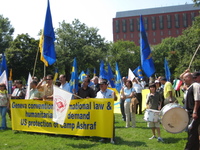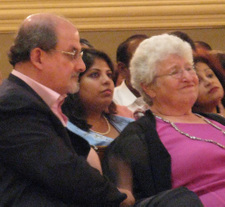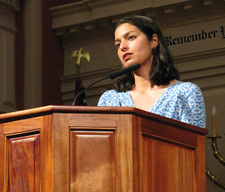by Natasha Tynes | Sep 9, 2008 | Everyday me!, Metro Daze, Political mayhem
 During my lunch break yesterday, I decided to take a walk about in Lafayette Park, next to the White House, to get away from my computer screen. As usual, there was a demonstration; same old, same old. However, this time the demonstration was organized by the People’s Mujahedin of Iran (PMOI) and it was about Camp Ashraf. I’m embarrassed to admit that I had never heard of Camp Ashraf so when I saw the demonstrators I was intrigued. I stood with them and listened to their protest.
During my lunch break yesterday, I decided to take a walk about in Lafayette Park, next to the White House, to get away from my computer screen. As usual, there was a demonstration; same old, same old. However, this time the demonstration was organized by the People’s Mujahedin of Iran (PMOI) and it was about Camp Ashraf. I’m embarrassed to admit that I had never heard of Camp Ashraf so when I saw the demonstrators I was intrigued. I stood with them and listened to their protest.
It turns out that Camp Ashraf is a famous political prisoner camp from the time of the Shah. According to Wikipedia, Camp Ashraf is currently an Iranian refugee camp in Iraq guarded by the United States military. Here is a bit more:
Ashraf is the seat of Mujahideen-e-Khalq (MeK) or People’s Mujahedin of Iran (PMOI), PMOI members in Iraq. It was in 1986 that the PMOI came to Iraq. The camp houses members of the PMOI who are regarded by coalition forces as protected people under the Geneva Conventions. This recognition was due to the neutrality and co-operation of the residents of Ashraf, before, during and after the war. The US General and commander of the 4th Infantry Division, Ray Odierno, referred specifically to this positive cooperation from the residents of Camp Ashraf.
 Putting my interest in the demonstration aside, the demonstrators were noisy, I have to admit. They had speakers, drums, and played loud Iranian music. After I had learned enough about their story I decided to walk back to the office. On my way back, I saw other Washingtonians on their lunch breaks. Some were eating sandwiches, others reading magazines, and some played chess in the park. Life in the park seemed normal as could be despite the intensity of the demonstration just steps away. I shouldn’t have been surprised. Life continues in Washington as normally as can be, despite the intense politics that keeps this city ticking.
Putting my interest in the demonstration aside, the demonstrators were noisy, I have to admit. They had speakers, drums, and played loud Iranian music. After I had learned enough about their story I decided to walk back to the office. On my way back, I saw other Washingtonians on their lunch breaks. Some were eating sandwiches, others reading magazines, and some played chess in the park. Life in the park seemed normal as could be despite the intensity of the demonstration just steps away. I shouldn’t have been surprised. Life continues in Washington as normally as can be, despite the intense politics that keeps this city ticking.
by Natasha Tynes | Aug 14, 2008 | Everyday me!, Metro Daze
My very good friend Jessica (a.k.a. "the yoga master") started a neat blog entitled Responsible Frugality. The concept of this blog is to document Jessica’s attempts at living a frugal yet sustainable and responsible lifestyle. She uses a bike as her only form of transportation and buys products from local farms. She also makes her own meals and lives green.
When she first told me about her blog, the first thought that came to my mind was Freecycle. "Do you use Freecycle?" I asked her. "I should," she answered
The Freecycle slogan is simple: "Changing the world one gift at a time." It is a concept that revolves around what I like to call the ‘American art of giving.’ Freecycle is a place where people simply give stuff away for free. Most of them are trying to "de-clutter" their lives by putting stuff they accumulated over the years to good use.
When I first heard the idea, I thought "Really, who wants to give stuff away for free?" Well, it turns out that the are many of those givers out there. All you have to do is go to the site, find a local group where you live, and then join their listserve and enjoy.
So far we’ve accumulated a very nice ping-pong table, a wheelbarrow, and a nearly new bike pump — and yes, all for free. This is how it works: You see the item listed, then you send the owner an email to see if they will give you the green light to go pick it up. Many owners leave their giveaways in their front or backyards so you just stop by and grab it; no muss, no fuss, easy and simple.
I’m not really sure if this idea exists in other parts of the world, but it somehow struck me as very American. Giving to charity and donating is something that is very deep-rooted here. Charity work and giving donations are things that many of my friends here are involved in — whether donating to political campaigns, religious institutions or animal shelters. When I hear about this art of giving I get this warm feeling, a feeling that reassures me that there is still hope in this nasty, nasty world we are living in.
Now, enough of the chatter, go check out Freecyle.
by Natasha Tynes | Jul 3, 2008 | Books, Metro Daze

During my teenage years in Amman in the late 80’s the name Salman Rushdie was the talk of the town. Shortly after the release of his book, Satanic Verses, Rushdie was portrayed in the local media as the devil incarnate and his book was banned in Jordan (and the rest of the Arab world if I’m not mistaken). Since then I have always been intrigued by Rushdie. What prompted him to write this very controversial book, I wondered. How can he lead a normal life after Khomeini issued a fatwa that legitimized his murder? Since then, I’ve followed his news with great interest. I read about the various awards he’s won, his knighthood by the Queen of England and his brief marriage to a supermodel.
So, when I read the news about his appearance in DC I quickly snapped up tickets to see him read from his latest book, The Enchantress of Florence, at an event organized by Politics and Prose. I expected to see a bitter, cantankerous man with nothing to offer but hate speech. I was mistaken. What I saw was a happy, highly likable man with a marvelous sense of humor. He was extremely down to earth and even made jokes that were self-deprecating. I made a quick comment when my turn came for him to sign my book. "You must be tired by now," I said pointing at the crowd of people waiting for his signature. He said no, he was not tired, then pointing to his pen he explained it was an "Olympic pen" that can sign in a very speedy manner.
I was also surprised by the lack of security guards around such a controversial figure. Somehow I thought he would be surrounded by an entourage of bodyguards. I was mistaken.I really did not notice any security personnel. Maybe they were undercover. Who knows!

I have to admit, though, I have never read any of his books. I started reading The Ground Beneath Her Feet and thought it was the best writing I had ever read. Unfortunately, I could not finish it because I had to return the book to my friend before I headed to London to pursue a post-graduate degree. Now, after attending his reading I feel I need to get this book soon.
Another reason I expected Rushdie to be aloof and stone-faced was a book reading (Unaccustomed Earth) by Jhumpa Lahiri that I attended last month. I was surprised by how distant and detached Lahiri seemed during her reading. It must be a writer thing, I thought to myself. Rushdie proved me wrong.
I have to admit that I’m a bit uncomfortable about writing about Rushdie on this blog because I know some readers will be very quick to attack me and accuse me of endorsing his controversial views. However, attending this reading left such an impression on me that I believe it deserves a whole post regardless of the consequences.
by Natasha Tynes | Sep 1, 2007 | Metro Daze
 One of the highlights of my day is my lunch break. And it’s not just because I get to take a breather and step away from the computer screen. I can also take a walk in nearby Lafayette Park and watch the chess players, the lobbyists, the dog walkers and of course the demonstrators.
One of the highlights of my day is my lunch break. And it’s not just because I get to take a breather and step away from the computer screen. I can also take a walk in nearby Lafayette Park and watch the chess players, the lobbyists, the dog walkers and of course the demonstrators.
Last Friday, while munching on my Cosi salad, I saw a large number of people chanting while holding banners as they approached the fenced gate of the White House. I finished my salad quickly and jogged over to the White House to see what was happening. To my surprise, I saw a sizable group of Iraqis carrying anti-Wahabism signs and other banners condemning the Saudi regime for what they believe is Saudi involvement in supporting the Iraqi insurgency. I assumed the demonstrators were Shia, mainly because of the Shia slogans some demonstrators carried that hailed Imam Hussein.
I spoke with a couple of demonstrators and they told me that they had come all the way from Detroit to stage their protest. They also informed me that before coming to the White House they had been demonstrating in front of the Saudi embassy in DC but they were not allowed inside. I took a picture of the demonstration using my outdated Nokia mobile phone, so I apologize for the quality. But if you look closely you can see some people staging what looks like a scene with an armed man (dressed in black) trying to kill another man. If you look still closer, you will see a banner saying أقتلوا الشيعة (Kill the Shia). I did not hang around for long, as I had to get back to work. On my way back I passed by the chess players, the lobbyists and the dog walkers. Life had resumed to normal in this cosmopolitan city, which has seen countless demonstrations.
A few days after seeing the protest, I read a news item about the banning of Alhayat newspaper by Saudi authorities due to a story the paper ran that said a Saudi extremist had played a key role in a violent Iraqi al-Qaida front group.
by Natasha Tynes | Aug 12, 2007 | Everyday me!, Metro Daze, Mi Familia
 One of the most amusing comments my mother made when we took her to Metro Center, the metro’s busiest station, was: "Why are they running?" Of course, she was referring to the fast pace of commuters who rush to catch their trains to get to their destinations on time. While my sister was teasing my mom about her comment, it suddenly hit me that after two years of living in the US, I’m actually one of those runners.
One of the most amusing comments my mother made when we took her to Metro Center, the metro’s busiest station, was: "Why are they running?" Of course, she was referring to the fast pace of commuters who rush to catch their trains to get to their destinations on time. While my sister was teasing my mom about her comment, it suddenly hit me that after two years of living in the US, I’m actually one of those runners.
I take the train everyday to get to work. My actual train ride is 30 minutes long but to make it to work at 9:00 am, I have to do my share of running. The minute the alarm goes off at 6:00 am, the running starts. From preparing breakfast, to packing lunches, to taking a shower and then taking care of some chores, there is no time to take a breather. I run the escalators in the metro to catch the train, then run the streets of DC to get to work on time if there were any delays in the Metro’s Red Line (a constant occurrence).
When my husband and I get home after work, there is also some running to do. From making dinner, to sorting the mail, and taking care of chores, we only stop when we fall asleep watching reruns of Law Order: Special Victims.
This is how my life has been the past two years: running in constant pursuit of the American Dream. Despite the hard work, I can easily say that I’m happy here and quite comfortable. Somehow, this constant fast-paced existence fits my lifestyle. Alright, time to wrap up this post. I have to run. [Picture: Courtesy the husband].
by Natasha Tynes | Jun 15, 2007 | Everyday me!, Jordan, my nation, Metro Daze
 One of the most gripping things that I saw when visiting the controversial Bodies Exhibition (in which real corpses are on display) was the real lungs of real smokers. The scientific exhibition, currently running in Washington, D.C., makes a point of showing visitors the grave dangers smoking does to our bodies by showcasing the difference between a smoker’s lungs and those of a non-smoker. Naturally the smoker’s real lung was in a dire state. It was all black and looked rigid and in extremely rough shape.
One of the most gripping things that I saw when visiting the controversial Bodies Exhibition (in which real corpses are on display) was the real lungs of real smokers. The scientific exhibition, currently running in Washington, D.C., makes a point of showing visitors the grave dangers smoking does to our bodies by showcasing the difference between a smoker’s lungs and those of a non-smoker. Naturally the smoker’s real lung was in a dire state. It was all black and looked rigid and in extremely rough shape. 
Visitors to the exhibition that are smokers are encouraged to throw away their pack of cigarettes in a glass box that has a sign above it stating: "On average a pack of cigarettes takes two hours and twenty minutes off your life. We’d like you to be around longer. Leave your cigarettes in the gallery and stop smoking now."
After I saw this, I had this sudden urge to take every smoker I know by the hand and bring them to this exhibition to show them how they are killing themselves — slowly but surely. While there, I kept thinking about my home country, Jordan, and how widespread smoking is there. Would an exhibition such as this one deter people from taking up this nasty habit? Will I live to see the day when young Jordanians find it "uncool" to smoke? Maybe. Only time will tell.
 During my lunch break yesterday, I decided to take a walk about in Lafayette Park, next to the White House, to get away from my computer screen. As usual, there was a demonstration; same old, same old. However, this time the demonstration was organized by the People’s Mujahedin of Iran (PMOI) and it was about Camp Ashraf. I’m embarrassed to admit that I had never heard of Camp Ashraf so when I saw the demonstrators I was intrigued. I stood with them and listened to their protest.
During my lunch break yesterday, I decided to take a walk about in Lafayette Park, next to the White House, to get away from my computer screen. As usual, there was a demonstration; same old, same old. However, this time the demonstration was organized by the People’s Mujahedin of Iran (PMOI) and it was about Camp Ashraf. I’m embarrassed to admit that I had never heard of Camp Ashraf so when I saw the demonstrators I was intrigued. I stood with them and listened to their protest. Putting my interest in the demonstration aside, the demonstrators were noisy, I have to admit. They had speakers, drums, and played loud Iranian music. After I had learned enough about their story I decided to walk back to the office. On my way back, I saw other Washingtonians on their lunch breaks. Some were eating sandwiches, others reading magazines, and some played chess in the park. Life in the park seemed normal as could be despite the intensity of the demonstration just steps away. I shouldn’t have been surprised. Life continues in Washington as normally as can be, despite the intense politics that keeps this city ticking.
Putting my interest in the demonstration aside, the demonstrators were noisy, I have to admit. They had speakers, drums, and played loud Iranian music. After I had learned enough about their story I decided to walk back to the office. On my way back, I saw other Washingtonians on their lunch breaks. Some were eating sandwiches, others reading magazines, and some played chess in the park. Life in the park seemed normal as could be despite the intensity of the demonstration just steps away. I shouldn’t have been surprised. Life continues in Washington as normally as can be, despite the intense politics that keeps this city ticking.





